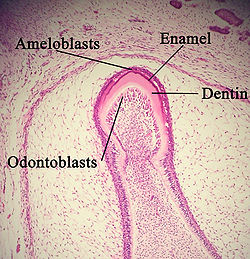Ameloblast
| Ameloblast | |
|---|---|

A developing tooth with ameloblasts marked.
|
|

The cervical loop area: (1) dental follicle cells, (2) dental mesenchyme, (3) Odontoblasts, (4) Dentin, (5) stellate reticulum, (6) outer enamel epithelium, (7)inner enamel epithelium, (8) ameloblasts, (9) enamel.
|
|
| Details | |
| Identifiers | |
| Latin | ameloblastus |
| Code | TE E05.04.1.1.2.3.20 |
|
Anatomical terminology
[]
|
|
Ameloblasts are cells present only during tooth development that deposit tooth enamel, which is the hard outermost layer of the tooth forming the surface of the crown.
Ameloblasts are derived from oral epithelium tissue of ectodermal origin. Their differentiation from preameloblasts (whose origin is from inner enamel epithelium) is a result of signaling from the ectomesenchymal cells of the dental papilla.
The ameloblasts will only become fully functional after the first layer of dentin (predentin) has been formed by odontoblasts. The cells are part of the reduced enamel epithelium after enamel maturation and then are subsequently lost during tooth eruption.
The life cycle of ameloblasts consists of six stages :
The murine ALC cell line is of ameloblastic origin.
Ameloblasts are cells which secrete the enamel proteins enamelin and amelogenin which will later mineralize to form enamel, the hardest substance in the human body. Ameloblasts control ionic and organic compositions of enamel. It is theorized that a circadian clock (24-hour) probably regulates enamel production on a daily cycle by the ameloblasts (similar to osteoblasts in production of bone tissue). Ameloblasts adjust their secretory and resorptive activities to maintain favorable conditions for biomineralization.
Each ameloblast is a columnar cell approximately 4 micrometers in diameter, 40 micrometers in length and is hexagonal in cross section. The secretory end of the ameloblast ends in a six-sided pyramid-like projection known as the Tomes' process. The angulation of the Tomes' process is significant in the orientation of enamel rods, the basic unit of tooth enamel.Distal terminal bars are junctional complexes that separate the Tomes' processes from ameloblast proper.
...
Wikipedia
